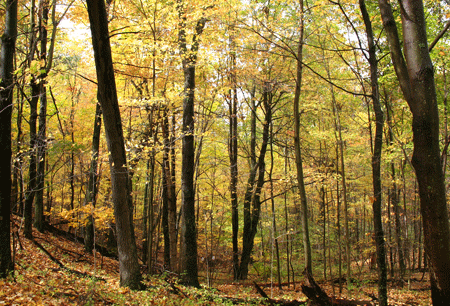 Big Woods Forest Inventory Plot
Big Woods Forest Inventory Plot
PIs: John Vandermeer, Ivette Perfecto, David Allen, Chris Dick
“Big Woods” is the name of the E. S. George Reserve’s intensively studied 23-ha forest plot and node in the Smithsonian Institution’s ForestGEO global network of forest monitoring plots. Stems of trees, shrubs, and lianas equal to or larger than 1 cm DBH have been mapped and monitored to document growth rates, mortality and recruitment. The trees and shrubs were censused four times: in 2003, 2008–2010, 2014 and 2021-2025 making Big Woods the oldest temperate forest plot in the ForestGEO network. During the 2014 tree census the plot included 33,690 tree and shrub individuals, comprising 45,564 stems representing 42 woody species and 22 families. Lianas were censused on 20 ha from 2017 to 2018 and included 679 individuals from seven species and four families. It is likely that the plot area has a history of managed burning by Native Americans and, after European colonization, fire suppression, use as a pastured woodlot, and finally agricultural abandonment in the early 1900s. The forest is transitioning from oak-hickory dominance to more mesic species (e.g., black cherry and red maple). The data from this plot offer an excellent resource to study the process of forest mesophication in the absence of a regular burning regime. The precise mapping of trees provides infrastructure for a broad range of ecological studies. The periodic census is an opportunity for students to get paid research experience in the reserve. The most recent census (2025) had a crew of 14 student workers. All the census data up to 2014 are freely available. Please contact the PIs for the more recent data and/or to propose research in the Big Woods plot.
Select Publications:
Alcántara, J., et al. 2025. Key concepts and a world-wide look at plant recruitment networks. Biological Reviews 100 (3): 1127-1151. https://doi.org/10.1111/brv.13177
Petri, L., and I. Ibáñez. 2024. Trait-related functional changes in understory forest community after invasion are driven by complementarity rather than displacement. Frontiers in Ecology and Evolution 12: 1325275. https://doi.org/10.3389/fevo.2024.1325275
Delavaux, C.S., LaManna, J.A., Myers, J.A. et al. 2023. Mycorrhizal feedbacks influence global forest structure and diversity. Communications Biology 6: 1066. https://doi.org/10.1038/s42003-023-05410-z
Weemstra, M., J. Zambrano, D. Allen, and M. N. Umaña. 2021. Tree growth increases through opposing above- and below-ground resource strategies. Journal of Ecology 109: 3502–3512. https://deepblue.lib.umich.edu/handle/2027.42/170826
Davies, S., et al. 2021. ForestGEO: Understanding forest diversity and dynamics through a global observatory network. Biological Conservation 253: 108907. https://doi.org/10.1016/j.biocon.2020.108907
Sedio, B. E., et al. 2021. Chemical similarity of co-occurring trees decreases with precipitation and temperature in North American forests. Frontiers in Ecology and Evolution 9: 679638. https://doi.org/10.3389/fevo.2021.679638
Allen, D., C. W. Dick, R. Burnham, I. Perfecto, and J. Vandermeer. 2020. The Big Woods research plot at the Edwin S. George Reserve, Pinckney, MI, USA. Miscellaneous Publications of the Museum of Zoology. University of Michigan. 207. https://hdl.handle.net/2027.42/156251
Allen, D, CW Dick, E Strayer, I Perfecto, & J. Vandermeer 2018. Scale and strength of oak-mesophyte interactions in a transitional oak-hickory forest. Canadian Journal of Forest Research. https://doi.org/10.1139/cjfr-2018-0131
Lutz, J., et al. 2018. Global importance of large-diameter trees. Global Ecology and Biogeography. 27(7): 849–864. https://doi.org/10.1111/geb.12747
Bemmels, JB, LL Knowles, & CW Dick. 2019. Genomic evidence of survival near ice sheet margins of some, but not all, North American trees. Proceedings of the National Academy of Sciences 116(17): 8431-8436. https://www.pnas.org/content/116/17/8431
Bonilla, N. O., E. G. Pringle. 2015. Contagious seed dispersal and the spread of avian-dispersed exotic plants. Biological Invasions, 17(12), 3409-3418.
Brym, Z. T., J. K. Lake, D. Allen, and A. Ostling. 2011. Plant functional traits suggest novel ecological strategy for an invasive shrub in an understory woody plant community. Journal of Applied Ecology 48: 1098-1106. DOI: 10.1111/j.1365-2664.2011.02049.x
Belasen, A., E. Burkett, A. Injaian, K. Li, D. Allen, & I. Perfecto. 2013. Effect of Sub-Canopy on Habitat Selection in the Blue-spotted Salamander (Ambystoma laterale-jeffersonianum unisexual complex). Copeia, 2013(2), 254-261.
Allen, D., J. Vandermeer, and I. Perfecto. 2009. When are habitat patches really islands? Forest Ecology and Management 258: 2033–2036.
Return to Research Projects list
